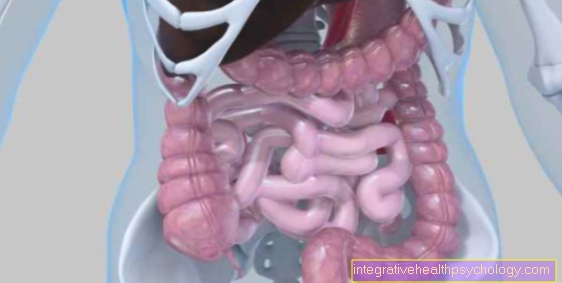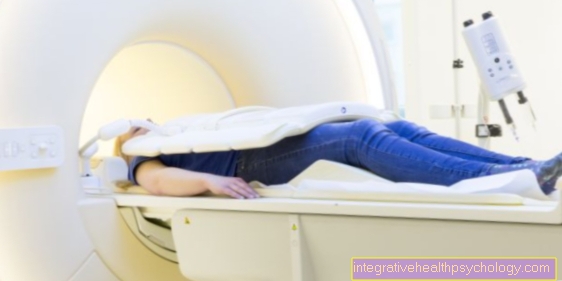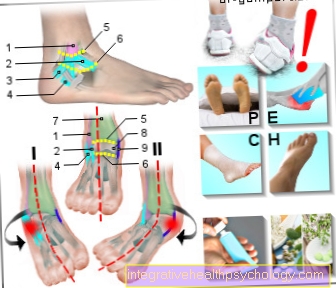Examinations during pregnancy
Pregnancy examinations are very important as they provide an opportunity to monitor the unborn child's growth and development.
Below you will find an overview and brief explanation of the most important examinations during pregnancy. For more information, see a reference to the main medical article under each section.

Initial examination
Regular examinations during pregnancy are necessary in order to identify risks of pregnancy at an early stage and, if necessary, to treat them. During the initial examination, the maternity card is issued for the pregnant woman. All important examinations and events during pregnancy are documented in this. Up to two pregnancies can be entered in a maternity card. The first examination includes a detailed discussion between the pregnant woman and the responsible gynecologist. In this conversation, possible illnesses of the pregnant woman and her family environment are addressed. If there are past pregnancies, questions will also be asked about these and any complications. Then the social circumstances of the pregnant woman and her job are discussed so that the doctor can assess whether these pose a risk to the pregnancy. In many cases, during the initial examination, the pregnant woman is advised on topics such as diet, flu vaccination and HIV test. In addition, the due date is calculated with the help of the information provided by the pregnant woman and the ultrasound.
Gynecological check
A detailed gynecological examination should also take place as part of the initial examination. The internal genitals are assessed using the speculum. In the early stages, the doctor may find a bluish discoloration of the vaginal lining, which is a sign of pregnancy. In addition, at the end of the speculum setting, a smear is taken, which is processed in the laboratory. Among other things, the tissue material is examined for early cancer detection and for an infection with chlamydia. Chlamydia are bacteria and, if not treated beforehand, can be passed on to the newborn and cause various infections, such as pneumonia. This is followed by a palpation examination of the uterus, fallopian tubes and ovaries. This exam assesses the size, location and consistency of the uterus. From the 6th week of pregnancy, the uterus can be felt enlarged and it appears loosened up compared to a non-pregnant uterus. Next, the cervix is assessed by means of the palpation examination. This is important to determine if the cervix has opened prematurely, which would require rapid intervention. During the examination, attention is paid to the length of the cervix and its consistency, among other things.
You can find detailed information on this topic at: Gynecological check
Blood test

Certain blood tests will be done as part of the initial examination. The results or the execution of the tests are recorded in the maternity record. First of all, the blood group and the Rhesus factor of the pregnant woman are determined. Rhesus negative women may need a so-called rhesus prophylaxis, so it is important to determine the rhesus factor. Furthermore, a so-called antibody search test is carried out. The antibody search test is repeated again between the 24th and 27th week of pregnancy. An antibody is a protein that binds to certain surface features of, for example, blood cells. The test is there to determine whether there are antibodies in the blood of the pregnant woman that could bind to the blood cells of the unborn child. The hemoglobin level in the blood is also determined at every check-up appointment. Hemoglobin is the red blood pigment that transports oxygen in the blood. The hemoglobin content can provide information about whether there is anemia. Low values should be observed and the gynecologist must weigh up whether further diagnostics are required to determine the cause of the anemia.
Exclusion of infection
With the help of the blood sample that is taken during the initial examination, tests are carried out in the laboratory to check for the presence of harmful pathogens. A search test for the causative agent of syphilis is carried out. In addition, it is determined whether there is sufficient immunity against rubella, as infection during pregnancy carries risks for the unborn child. If there are doubts in the 32nd week of pregnancy about whether there is sufficient immunity to hepatitis B, a protein in the blood that is on the surface of the hepatitis B virus is determined. If the test is positive, the newborn must be vaccinated against this virus immediately after birth. In addition to these prescribed examinations, other tests can also be carried out. The gynecologist should advise every pregnant woman about an HIV test and document this in the maternity card. The pregnant woman decides whether the test should be carried out. In pregnant women who have regular contact with cats, it is advisable to carry out an examination for toxoplasmosis, as the pathogen can be transmitted to humans via cat feces and raw meat.
Checkups
At every check-up appointment, the body weight is determined and the blood pressure measured. Excessive weight gain can indicate water retention in the legs, as can be the case with preeclampsia. Preeclampsia is a pregnancy disease that is associated with high blood pressure and can complicate both pregnancy and the puerperium. For this reason, blood pressure is also measured regularly so that high blood pressure is not overlooked, as it can harm the unborn child. In addition, a physical examination is carried out in which, among other things, the height of the upper edge of the uterus is determined. In the 6th week of pregnancy, it protrudes just above the pubic bone. On the due date, the upper edge lies under the costal arch. From the 20th week of pregnancy onwards, a further palpation test can be used to determine how the child is lying in the uterus and on which side the back is. In addition to these specific examinations, a conventional physical examination of the other organ systems is also carried out. This is ideally carried out during the initial examination. The physique of the pregnant woman is also of interest, as this can give clues as to whether there will be difficulties in labor, for example.
Between the 24th and 28th week of pregnancy, the glucose tolerance test will continue to be performed to detect possible gestational diabetes.
You can find detailed information on this topic at: Check-ups during pregnancy
Urinalysis
In addition to the physical examination, a urine examination is carried out at each screening appointment. This is examined for proteins, glucose, blood components and nitrite using a test strip. Proteins in the urine can indicate preeclampsia, a pregnancy disorder with high blood pressure. The proteins in the urine indicate that there is damage to the kidneys. Glucose, a sugar, is in the urine when the kidneys are no longer able to filter it adequately due to the high levels of sugar in the blood. Sugar in the urine could therefore indicate gestational diabetes and must be confirmed or excluded with further tests. If blood components such as white or red blood cells and nitrite are present in the urine, there is a suspicion that a urinary tract infection is present. A urinary tract infection should also be treated if the pregnant woman does not notice any symptoms. Before antibiotics are administered, the pathogen should be identified by culturing in the laboratory so that the antibiotics can be administered in a targeted manner.
You can find detailed information on this topic at: Urinalysis during pregnancy
Sonography

According to the maternity guidelines, three ultrasound exams are scheduled during pregnancy. The first takes place between the 9th and 12th week of pregnancy. During this first examination, it is checked whether the embryo is properly in the uterus and whether there is a multiple pregnancy. Then it is checked whether the embryo shows timely development and whether a heart action can be detected. Finally, the crown-rump length is measured and the duration of pregnancy is corrected on the basis of this. The second ultrasound examination takes place between the 19th and 22nd week of pregnancy. The first step is to check whether the placenta is properly seated in the uterus and assess the amount of amniotic fluid. This is followed by the sonographic examination of the child. Attention is paid again to the action of the heart and now also to children's movements. Furthermore, the entire body of the unborn child is examined and some measurements are carried out which, if the values deviate, may indicate undesirable developments. The third ultrasound is performed between the 29th and 32nd week of pregnancy. The placenta is assessed again and the child's development is checked. In addition, the weight can be estimated based on measured values.
You can find detailed information on this topic at: Ultrasound in pregnancy
Obstetric Doppler sonography
Doppler sonography is used to display and measure the blood flow in the vessels. During pregnancy, this examination is used to check the blood supply to the unborn child in order to detect a deficiency at an early stage. Doppler sonography is usually carried out in the second half of pregnancy, especially if the child is suspected of slowing growth or a malformation.Other reasons for performing this examination are pregnancy high blood pressure, past birth defects or fetal death, an abnormal CTG (cardiotocogram) or a multiple pregnancy with non-parallel growth of the children. During the examination, the blood flow is measured at various points, both in the mother and in the child. The flow velocity is measured in the mother's uterine artery, in the umbilical cord arteries and in one of the cerebral vessels of the unborn child. These measured values can be used to assess whether there is an insufficient supply of the child.
You can find detailed information on this topic at: Doppler sonography in pregnancy
CTG
Cardiotocography (abbreviation CTG) is an ultrasound-based procedure to measure the heart rate of the fetus.
At the same time, the mother's contractions are recorded using a pressure gauge (Tokogram). A CTG is routinely recorded in the delivery room and during childbirth.
Other reasons for a CTG examination are, for example:
- an impending premature birth
- Multiple pregnancies
or - Irregularities in the child's heartbeat.
In the maternity guidelines, CTG admission is not required during the preventive medical examination. However, some gynecologists also perform this examination from the 30th week of pregnancy. The CTG can be used to determine whether the unborn child's heart is beating properly or possibly too fast or too slowly. Reasons for an increased heart rate are, for example, stress or an insufficient supply of the tissue with oxygen (Hypoxia).
A lack of oxygen, as well as the vena cava compression syndrome, can also lead to a decreased heart rate.
In the curves that the CTG outputs, the doctors also pay attention to the baseline excursions up or down. A rash upwards (Acceleration), i.e. a short-term acceleration of the fetal heart rate, is normal and is triggered by the child's movements. A downward rash, which corresponds to a slowdown in the heart rate, must be carefully observed and, depending on the labor activity, results in different measures.
You can find detailed information on this topic at:
- CTG
and - Normal CTG_values
Prenatal diagnostics
Prenatal diagnosis comprises a number of different invasive and non-invasive examination options that are carried out on the pregnant woman and on the fetus. They are to be considered as additional examinations and are therefore not usually covered by statutory health insurance. The procedures given here are only a selection of the many possibilities. In the first trimester between the 12th and 14th week of pregnancy, a sonographic measurement of the neck transparency can be performed. The examination is non-invasive and increased transparency of the neck area can indicate an anomaly in the unborn child. This can be further clarified after a risk assessment using an amniocentesis. Amniocentesis involves taking amniotic fluid and analyzing the child's chromosomes. The triple test is a blood test in which three markers in the mother's blood are determined and the risk of a fetal anomaly is calculated using an algorithm. In addition, the child's DNA can be filtered from the maternal blood and examined for abnormalities. An invasive method that can be used very early in pregnancy is chorionic villus sampling. This procedure involves taking tissue from the placenta and doing genetic tests on it.
You can find detailed information on this topic at: Prenatal test
















-mit-skoliose.jpg)












